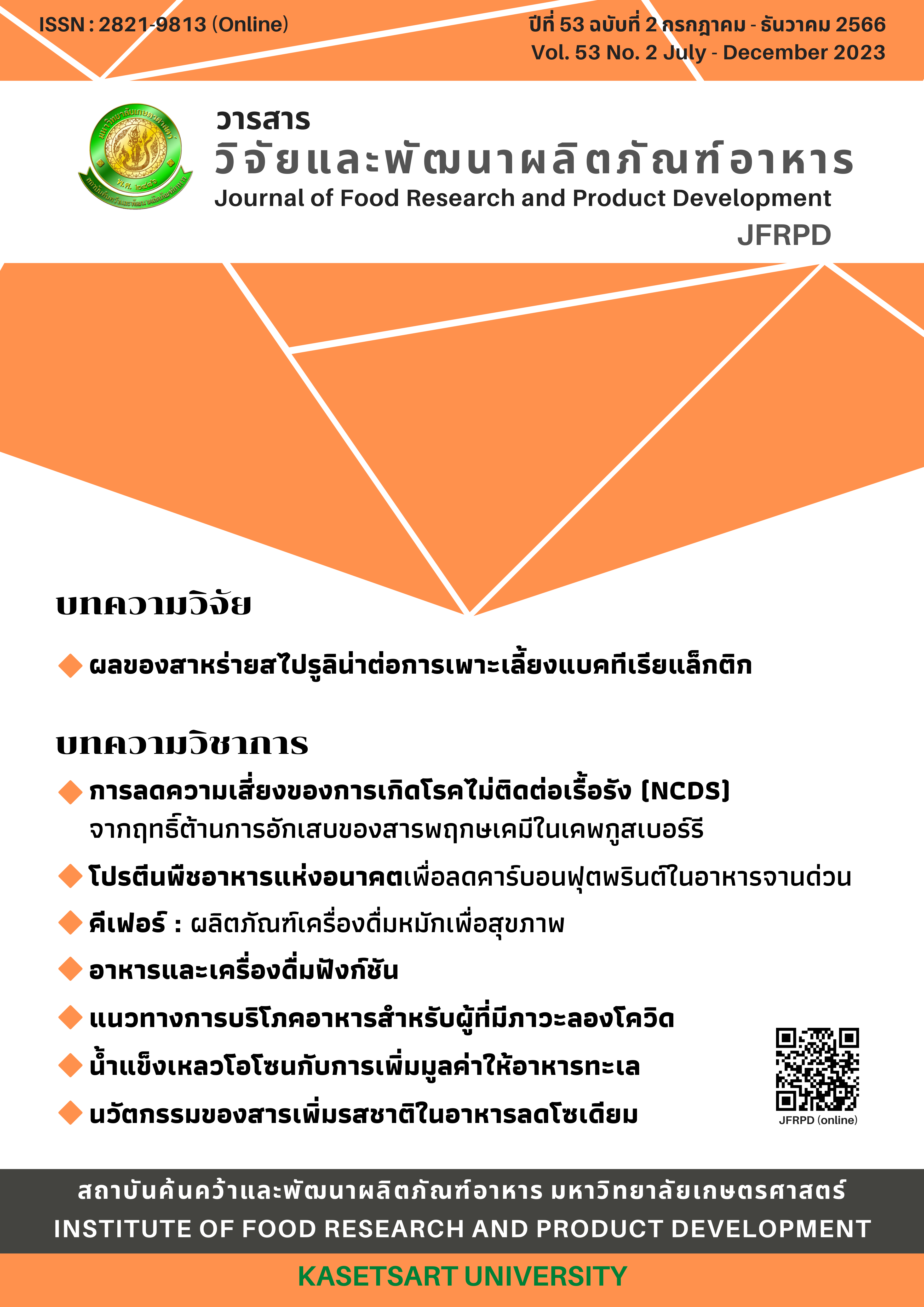น้ำแข็งเหลวโอโซนกับการเพิ่มมูลค่าให้อาหารทะเล Adding value to seafood products using ozonized slurry ice
##plugins.themes.bootstrap3.article.main##
摘要
Saltwater harvesting maintenance for preservation of the quality of aquatic animals caught can slow down the qualitative deterioration of food chain to consumer and adds value to aquatic animals caught. Slurry Ice (SI) and Ozonized Slurry Ice (OSI) are technologies used to raise the standard of seafood. Thailand has the potential to raise/catch wild aquatic animals to a certain extent in this region. This can be seen from fresh seafood along both sides of the Andaman Sea and the Gulf of Thailand, not counting the adoption of a large number of cultures in the pond. If the technology of using SI or OSI are applied to the post-catch care process throughout the transportation to the consumer. It is considered to add value to those aquatic animals. Through the good quality of food in terms of color, smell and taste that are similar to fresh aquatic animals. It has been accepted by consumers in terms of images that are colorful, bright, and naturally beautiful iIncluding a good taste. All has been well received and meets the standards of fresh seafood as well.
Keywords : slurry ice, ozone, seafood, postharvest activity (aquatic animals)
บทคัดย่อ
การดูแลหลังการจับสัตว์น้ำเค็มเพื่อรักษาคุณภาพของสัตว์น้ำที่จับได้ ช่วยชะลอการเสื่อมคุณภาพของอาหารในห่วงโซ่อาหารจนถึงมือผู้บริโภค และเป็นการเพิ่มมูลค่าให้กับสัตว์น้ำที่จับได้ น้ำแข็งเหลว (Slurry Ice, SI) และน้ำแข็งเหลวโอโซน (Ozonized Slurry Ice, OSI) เป็นเทคโนโลยีรูปแบบหนึ่งที่ถูกนำมาใช้เพื่อยกระดับมาตรฐานให้กับอาหารทะเล ซึ่งประเทศไทยมีศักยภาพในการเลี้ยง/การจับสัตว์น้ำจากธรรมชาติได้ในระดับหนึ่งในภูมิภาคแห่งนี้ ดังจะเห็นได้จากอาหารทะเลที่สดใหม่ จากฝั่งทะเลอันดามันและทะเลอ่าวไทย ไม่นับรวมสัตว์น้ำที่มีการเลี้ยงในบ่ออีกเป็นจำนวนมาก การนำเทคโนโลยีด้านการใช้ SI หรือ OSI มาประยุกต์เข้ากับขั้นตอนการดูแลหลังการจับสัตว์น้ำตลอดการขนส่งจนถึงมือผู้บริโภค นับว่าเป็นการเพิ่มมูลค่าให้แก่สัตว์น้ำเหล่านั้น ผ่านคุณภาพที่ดีของอาหารทั้งในแง่ สี กลิ่น รสชาติที่ใกล้เคียงกับสัตว์น้ำที่มีคุณภาพเหมือนของสดใหม่ ได้รับการยอมรับจากผู้บริโภคทั้งในด้านภาพลักษณ์ที่มีสีสัน สด ใส สวยตามธรรมชาติ และมีกลิ่นรสที่ได้รับการตอบรับเป็นอย่างดีและผ่านตามเกณฑ์มาตรฐานของอาหารทะเล
คำสำคัญ : น้ำแข็งเหลว โอโซน อาหารทะเล การดูแลหลังการจับ (สัตว์น้ำ)
##plugins.generic.usageStats.downloads##
##plugins.themes.bootstrap3.article.details##
参考
Piñeiro, C., J. Barros-Velázquez and S. P. Aubourg. Effects of newer slurry ice systems on the quality of aquatic food products: A comparative review versus flake-ice chilling methods. Trends in Food Science and Technology. 2004;15(12):575-82.
Kauffeld, M., M. J. Wang, V. Goldstein and K. E. Kasza. Ice slurry applications. International Journal of Refrigeration. 2010;33(8):1491-505.
Pan, C., S. Chen, S. Hao and X. Yang. Effect of low-temperature preservation on quality changes in Pacific white shrimp, Litopenaeus vannamei: a review. Journal of the Science of Food and Agriculture. 2019;99(14):6121-28.
Lyu, F., R. Zhu, W. Tang, Y. Ding and J. Liu. Progress of ice slurry in food industry: Application, production, heat and mass transfer. International Journal of Food Science and Technology. 2022;57(2):842-55.
Campos, C. A., O. Rodríguez, V. Losada, S. P. Aubourg and J. Barros-Velázquez. Effects of storage in ozonised slurry ice on the sensory and microbial quality of sardine (Sardina pilchardus). International Journal of Food Microbiology. 2005;103(2):121-30.
Herland, H., M. Esaiassen, M. Cooper and R. L. Olsen. Quality of farmed Atlantic cod: Effects of season and storage. Aquaculture Research. 2010;41(8):1203-10.
Qing, Z. Z., K. A. Thorarinsdottir and G. Olafsdottir. Quality changes of shrimp (Pandalus borealis) stored under different cooling conditions. Journal of Food Science. 2005;70(7):S459-S466.
จุฑา มุกดาสนิท และคณะ. นวัตกรรมน้ำแข็งเหลวรักษาคุณภาพเนื้อปลาสด. [อินเทอร์เน็ต]. 14 มิ.ย. 2566 [เข้าถึงเมื่อ 25 มิ.ย. 2566]. เข้าถึงได้จาก: https://www.thaipbs.or.th/program/WanmaiVariety/watch/N9xrKO
Kim, J. G., A. E. Yousef and S. Dave. Application of ozone for enhancing the microbiological safety and quality of foods: A review. Journal of Food Protection. 1999;62(9):1071-87.
Aubourg, S. P., V. Losada, J. M. Gallardo, J. M. Miranda and J. Barros-Velázquez. On-board quality preservation of megrim (Lepidorhombus whiffiagonis) by a novel ozonised-slurry ice system. European Food Research and Technology. 2006;223(2):232-7.
Chen, J., J. Huang, S. Deng and Y. Huang. Combining ozone and slurry ice to maximize shelf-life and quality of bighead croaker (Collichthys niveatus). Journal of Food Science and Technology. 2016;53(10):3651-60.
ภาควิชาผลิตภัณฑ์ประมง Department of Fishery Products. การประยุกต์ใช้น้ำแข็งเหลวจากน้ำทะเลรักษาคุณภาพของกุ้งลาดำ. [อินเทอร์เน็ต]. 28 มิ.ย. 2566 [เข้าถึงเมื่อ 28 มิ.ย. 2566]. เข้าถึงได้จาก: https://www.facebook.com/100080103653342/posts/pfbid034foimKSkwcoTGVTVEzZmZ433sXmEN2HueMcfkLUHyvS864cGYAtCwx93c5WFvSu6l/?mibextid=cr9u03
Campos, C. A., V. Losada, Ó. Rodríguez, S. P. Aubourg and J. Barros-Velázquez. Evaluation of an ozone-slurry ice combined refrigeration system for the storage of farmed turbot (Psetta maxima). Food Chemistry. 2006;97(2):223-30.
Okpala, C. O. R. Changes in some biochemical and microbiological properties of ozone-processed shrimps: Effects of increased ozone discharge combined with iced storage. Journal of Food and Nutrition Research. 2018;57(1):48-56.

